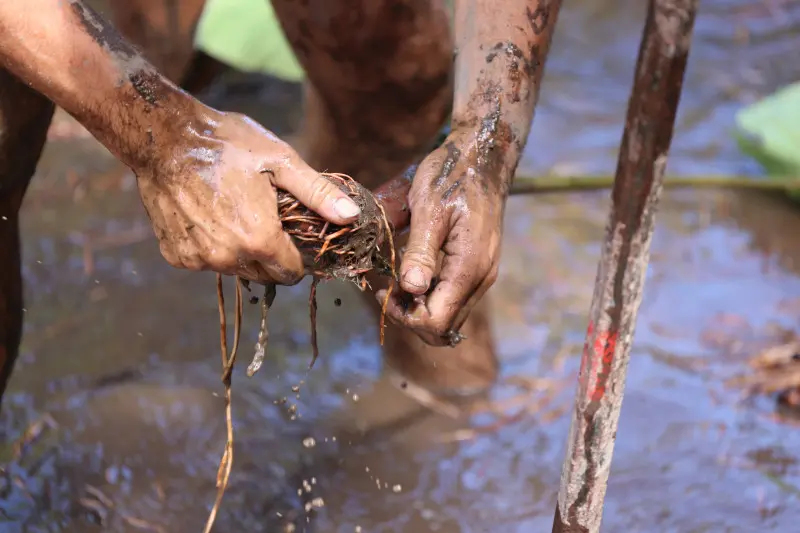Nearly two dozen high school haumāna, most from West Maui, embarked on a summer camp-style learning journey in Honokōhau Valley. They willingly disconnected from technology for a chance to connect with ‘āina, wai and ‘ike kūpuna.
The first ever Kumu Wai camp was the brainchild of the ‘āina-focused nonprofit Nā Mamo Aloha ‘Āina o Honokōhau.


“We noticed that there’s not a lot of programs for older kids, and that’s why we chose to do this program and they’ve been engaged from the moment they got here,” said Karyn Kanekoa, a camp leader with Nā Mamo Aloha ‘Āina o Honokōhau.
Funding for Kumu Wai was made possible by Kamehameha Schools Kaiāulu through a Summer Boost program, which enhances Hawaiian culture-based and place-based youth learning opportunities while school is on break. In this instance, it also served as a chance to uplift young kānaka from West Maui who have endured a great deal since August 8, 2023.
“Kamehameha Schools is always looking for ways to support Native Hawaiians, to support the lāhui and to be able to support this group specifically, with people that have just gone through something that's so tragic. It’s amazing to see these kids be able to be back on ʻāina, having fun learning about where they’re from, where their kūpuna are from and reconnecting to their place again,” said Kapua Chang KSK’08, a project manager for the Community Engagement Division of KS Kaiāulu.
The youth camp was based on the valley floor of Honokōhau where the nonprofit Hui Nā Mamo is working to restore some of the loʻi kalo patches that once numbered in the thousands. Some haumāna prepared new loʻi patches to be flooded and planted, others helped tend to the ʻauwai system that brings wai to the loʻi kalo.


Another group got knee-deep to huki and began processing kalo that would be part of ‘aina ahiahi the next day. One of the Nā Mamo alakaʻi, Holden Kalamaʻehu Takahashi KSM’10, used the huki time as a hands-on opportunity to teach ‘ōlelo Hawaiʻi as well.
“The return back to these practices within their own language and within their own place is the most important thing. We have all these outside influences, we have the effects of colonization, climate change and moreso what we’ve seen in Lahaina as a culmination of those things. So us being able to reconnect to the core of the practice, the core of the language and just the core of the value system represents a foundation to mitigate those issues.”
Other daytime activities included journeys ma uka to see the kumu wai — the source of the Honokōhau Stream where a plantation-era dam and diversions have greatly impacted the valley’s food-growing capabilities.

A pōhaku with the number 269 etched in it dates back to the 1800s. It marked a particular loʻi for tax collection purposes in Hawaiian kingdom days. All loʻi in Honokōhau had these pōhaku and were situated in the same position (ma uka/hikina corner) for ease in tracking.
A pōhaku with the number 269 etched in it dates back to the 1800s. It marked a particular loʻi for tax collection purposes in Hawaiian kingdom days. All loʻi in Honokōhau had these pōhaku and were situated in the same position (ma uka/hikina corner) for ease in tracking.
Along the way, haumāna discovered pōhaku dating back to the 1800s with numbers etched on them. These served as markers for individual loʻi kalo for taxation purposes during the Hawaiian kingdom. Old maps show the valley once had around 5,000 such loʻi kalo and corresponding numbered pōhaku.
At night, these high schoolers listened to presentations from special guests, including traditional practitioners with deep ancestral ties and knowledge of the moʻolelo of this area.
Amid the numerous learning opportunities, haumāna had plenty of time for launa and leʻaleʻa—swimming in the stream, playing games and getting to know ‘ōpio from different places, including one who had come from Rapa Nui to attend FestPAC and ended his stay to take part in the camp.
For Kaila Nagasako and her māhoe, Kalei, the Kumu Wai camp was a welcome respite. The 14-year-olds' Lahaina home was destroyed August 8th.
“It feels like I’m at ease and it feels good that I can get away and bond with other people and not have to think about that,” said Kaila Nagasako.
17-year-old Jonah Hailama Blando-Kaaihue fought back tears when asked about the importance of passing on the ‘ike from his kūpuna, including his tūtū, a master lauhala weaver. He hopes to learn to weave too, but for now is happy to share the importance of mālama ʻāina with those around him.
“It gives me a good feeling inside when I teach my little sisters or my little brothers how to plant and grow things,” said Blando-Kaaihue.
By all accounts, the inaugural Kumu Wai camp proved to be a success as youth connected with place and people in a deep, culturally rooted experience.
Kumu Wai camp organizer Karyn Kanekoa says their hui is already working on other opportunities to bring the camp experience to more West Maui ‘ōpio in the months and years to come.
“Now is the time for our keiki to get connected, and with programs like this, I feel we can do that. It’s also great to have the support of Kamehameha Schools. In the planning, you could tell that it’s just as important to KS as it is to us to bring the keiki out here.”






TAGS
kaiāulu,
community engagement,
aloha ʻāina,
ʻike hawaiʻi,
native hawaiian identity
CATEGORIES
Kaipuolono Article, Regions, Maui, Moloka’i and Lana’i, Themes, Culture, Community, KS Announcements, Newsroom, Maui, Community Education, Community Events, Alumni, Kapalama, Maui, KS Kaiāulu, Oiwi Leaders, Ho‘ōla Maui, Lahaina, Community
Print with photos
Print text only










